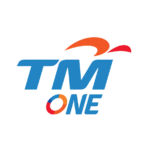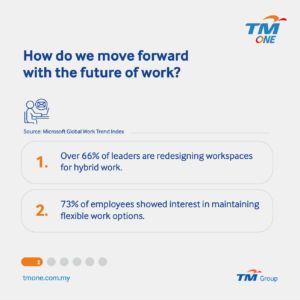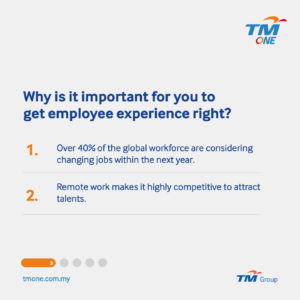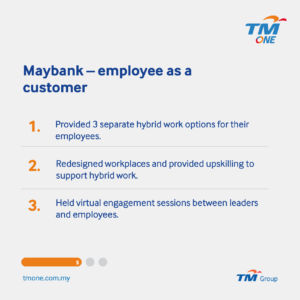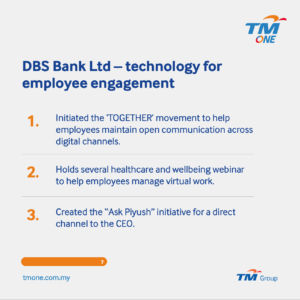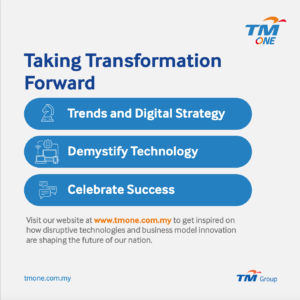
The pandemic has caused a seismic shift in our relationship with work. In this article, we share 3 best practices to give you inspiration on how to get your EX right.
The pandemic caused a seismic shift in our relationship with work. Past location-based practices made way for a remote, employee-centric model. However, with vaccination rates showing a glimmer of hope back to normalcy, how do we move forward with the future of work?
The answer here is clear. In fact, the Microsoft Global Work Trend Index found that over 66% of leaders say their company is considering redesigning their workplaces to suit a hybrid work model.1
Employees share the same aspirations, with over 73% showing interest in flexible remote work options. Consequently, your team must prepare for the hybrid work future.
Managing these demands is mission-critical as over 40 per cent of the global workforce are considering changing jobs within the next year – nearly double the amount from past years.
This situation places a lot of pressure on how you retain and attract talents. To help you, we believe your company should centre decisions across these three main questions:
- The culture question: Do your employees celebrate each other’s success?
- The technology question: Is technology helping your employees work better?
- The environment question: Is your workplace designed for upliftment?
There is no definite answer on how your company can answer these questions. It differs significantly from each industry and, most importantly, to each unique employee. A robust and enabling employee experience must cover your employee’s entire life cycle.
In this article, we share three best practices from three distinct companies to give you inspiration on how you can tackle these employee experience questions.
Maybank – Treating employees as customers
“Beyond the pandemic, the overall changing work landscape, in line with the global outlook, and the push towards being more inclusive, point towards a combination of the different work settings to adapt to the different needs of both the workplace and the workforce”2 – Datuk Nora Manaf, Group Chief Human Capital Officer
Maybank facilitated the transition of 82% of its workers to a work-from-home (WFH) setting within days when the lockdown struck. From this experience, Maybank took notice of the several groups of people in its workforce based on their nature of work.
In response to their staff and work nature, Maybank laid out a comprehensive hybrid approach to suit their employees’ lifestyle and career aspirations. This strategy included three main approaches to work:
- Work from home: Allows their employees to work from home for the long term, focusing on virtual interactions and engagements.
- Flexible working arrangements: Supports staff through different stages in their lives and careers. These include flexible hours, ‘phasing in and out’, various leave types and employee support schemes.
- Mobile work arrangements: A modern and tracked arrangement where employees are completely ‘mobile’ to discuss and agree on a model that works for them. This model focuses primarily on outcomes, rather than input.
Maybank seeks to complement these initiatives with new workplace designs and upskilling initiatives to support blended working arrangements.3
Apart from these employee-centric models, Maybank recognised that virtualisation of work could severely impact collaboration and communication.
It becomes easy for us to lose touch with our employees when we rarely meet them in person. As such, Maybank took proactive steps to counter this.
For example, Maybank initiated the Leaders Teaching Leaders (LTL) program, which held virtual sessions for the group EXCO to engage consistently with his employees. In 2020, over 630 sessions of LTL were participated by the Group EXCO.
Maybank shows us that a large corporation in a highly regulated environment does not limit a company to treating its employees with empathy. It recognised the changing demands from employees, and responded flexibly.
Accenture – Prioritising employees’ learning and development
“Our unwavering commitment to inclusion and diversity unleashes innovation and creates a culture where everyone feels they have equal opportunity” – Julie Sweet, Chair and CEO
The growing need for digital skills can sometimes get too overwhelming for our employees. Coupled with the need to balance work, employees can find it challenging to match technology’s pace.
To help their employees, Accenture introduced the Future Talent Platform – a digital upskilling platform. The aim was to ensure that its workforce had the channels it needed to bridge skill gaps with ease and affordability.
This program is highly customisable and provides recommendations for upskilling based on an employee’s role. The platform hosts over 2,400 courses on the Accenture Academy platform and over 8,000 courses from content partners.
In 2021, Accenture reported an increase in training hours by 46% from fiscal 2020 to over 31 million training hours.4 They managed to average approximately 60 hours of training per person.
In addition, since March 2020, the company trained more than 70,000 employees on highly sought-after skills, such as cloud computing and remote collaboration tools.
These initiatives are vital today, where employees may feel threatened by technology replacing their jobs. Investing in our employees shows that we care about their growth and development. In return, companies can ensure they can retain their talents for the long term.
DBS Bank Ltd, Technology as a catalyst for employee engagement
“Conventional wisdom is that it is difficult for a legacy company to transform at scale. So, in embarking on change, some organisations keep the old and new organisations separate. My view is that to drive transformation at scale, you must attack the core — and make it mainstream. Even though it’s daunting, I am a firm believer that one needs to create change in the company-wide culture.”5 – Piyush Gupta, DBS Bank CEO
Keeping employees engaged with their work can be difficult within a remote setting. Communication lines may weaken, and employees may feel disconnected and alienated. DBS shows how technology, when used effectively, can drive coordination, efficiency, and collaboration.
DBS Bank initiated the “TOGETHER” movement to help its employees navigate through the pandemic as a team.6 The bank wanted to make sure that its employees remained connected and engaged by encouraging open communication throughout the pandemic. The three main initiatives of this movement are as follows:
- Communication program: DBS created guides on how employees can have a smooth transition into work-from-home settings. This included practical guides on how to organise work corners and create productive routines.
- Encourage social connections through digital platforms: DBS ensured teams remain connected via the bank’s video conferencing platform. DBS introduced team leaders methods to make sure teams connected through initiatives such as daily check-ins.
- Care packages for personal wellbeing: DBS held several healthcare and wellbeing webinars to help its employees pave their way through the pandemic. Confidential counselling and mental wellbeing programmes were also readily available.
DBS also uses digital tools to encourage transparent communication across the workforce. Digital tools with empathy are a powerful combination. For instance, DBS initiated the “Ask Piyush” to create a direct communication channel to the CEO himself.
Employees can ask questions, comment, and give suggestions to the CEO directly via this digital tool. This channel helps to break the traditional hierarchies and encourages more open communication across the bank. Consequently, such initiatives helped DBS create a conducive environment for its employees to thrive.
References:
1 Microsoft. (2021, March 22). The Next Great Disruption Is Hybrid Work—Are We Ready? Retrieved 28 October 2021, from https://www.microsoft.com/en-us/worklab/work-trend-index/hybrid-work2 Lee, J. (2021, July 25). Maybank goes flexi. The Star. Retrieved 29 October 2021, from https://www.thestar.com.my/business/business-news/2021/07/26/maybank-goes-flexi3 Surviving The Impact of Covid-19: WFH is here to stay, looking more hybrid. (2021, January 14). The Edge Markets. Retrieved 25 October 2021, from https://www.theedgemarkets.com/article/surviving-impact-covid19-wfh-here-stay-looking-more-hybrid
4 Accenture. (2020, October 21). Accenture’s Annual Reports. https://www.accenture.com/my-en/about/company/annual-report5 “At DBS, we act less like a bank and more like a tech company.” With DBS Bank CEO Piyush Gupta. (2018, October 12). DBS Innovates. Retrieved 25 October 2021, from https://www.dbs.com/innovation/dbs-innovates/at-dbs-we-act-less-like-a-bank-and-more-like-a-tech-company-with-dbs-bank-ceo-piyush-gupta.html6 Sustainability Report 2020 Stronger Together | DBS Bank. (2021, March 2). DBS. Retrieved 26 October 2021, from https://www.dbs.com/sustainability/reporting/sustainability-report
Read Now